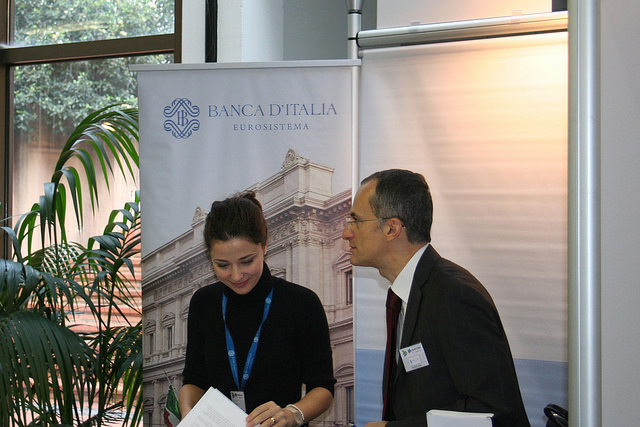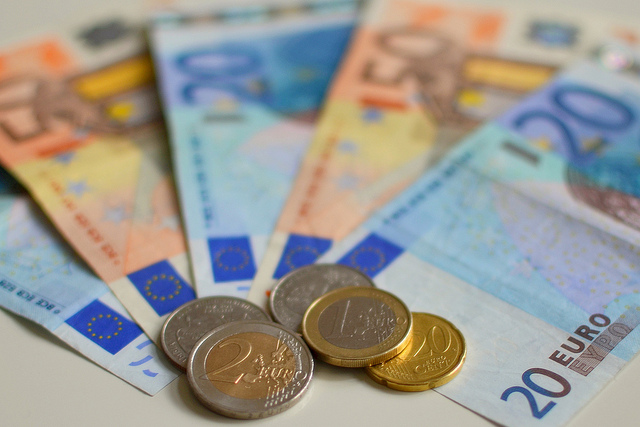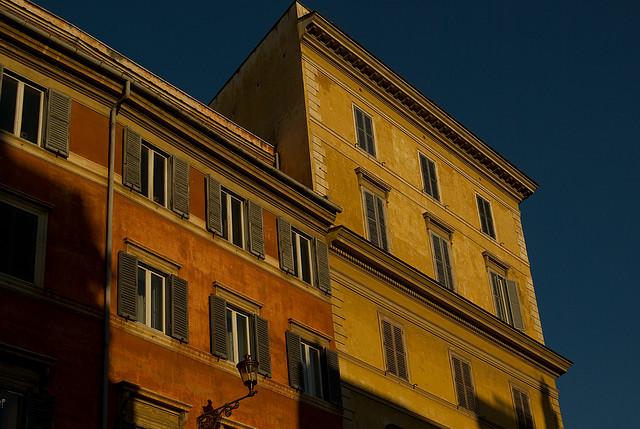Financing: how to buy real estate in Italy

(by Job Meeting at www.flickr.com)
A brief introduction: my name is Paolo and I am a realtor in the US (Maryland and DC). I also bought a property using financing it in Bolsena, Italy so I hope I can give you some suggestions about mortgages.
When I applied for the mortgage (2007), lending regulations were pretty relaxed, but that is not the case anymore. However right now, after the pandemic, with a war going on, you might be able to pick up a deal: it’s not a case that Baron Rothschild, 18th century nobleman and member of the famous banking family once said that “The time to buy is when there’s blood in the streets.” Warren Buffet’s philosophy should also be mentioned here: “Be fearful when others are greedy, and greedy when others are fearful.”
If you are planning to buy real estate in Italy you need to decide how you are going to finance your new property.
Unless you plan on paying the entire amount in cash, you will have to get a mortgage either in US dollars or in euros depending upon exchange rates. If you think the euro is low, better get financing in US dollars in the States. If you think the euro is high, but it is going to go down, better get financing in euros and pay off the loan with cash.
Example one:
You need $100,000 and the euro-to-dollar rate is 0.80 – the dollar being stronger: get a $80,000 home equity loan in the US, pay the entire amount of the house at this low exchange rate and slowly pay off your controlled mortgage in the US.
Example two:
You need $100,000 and the euro to dollar rate is 1.50 – the euro being stronger: Do not get a $150,000 dollar home equity loan here in the US, instead get a mortgage in euros over in Italy, pay off the rates until the dollar raises against the euro and, when the dollar is back closer to 1 : 1, you have the option to pay back the remainder of the loan.
December 2022:
The exchange Euro Dollar is close to 1:1 … well it seems a pretty good time to buy at this moment. After all any purchase in Italy is 20% cheaper.
Mortgages

You will have to assess which currencies you are required to deal in.
If you take your financing in the United States then your mortgage will be in dollars. After raising your financing in dollars, you’d have to do a money transfer for the required amount to Italy and to exchange your dollars to euros.
If that is the case the easier way to acquire property is to get a home equity line on your property in the country where you live. This may have the advantage of carrying tax deductible interest (ask your accountant in for more information since rules changed on HELOC recently). Right now the cost of the HELOC loan is about 4% (End of 2022). If you do not have that option, or you do not want to use it, you can get a house loan in Italy: it is possible and I know people who did it. Getting a loan in Italy can also offset the high Euro (good strategy if you think the Euro will go down in value).
The main advantage of getting a mortgage in Italy instead of the United States is that it could offset a strong European currency and rates are much lower ( currently about 3% in January 2025). Right now, the rates in Italy are lower than in the US, and if the currency markets work in your favor, then there may be savings arising from a favorable fluctuation in the exchange rate.
If the dollar rises in value against the euro, then you will need to spend fewer dollars to buy the same amount of euro you initially borrowed. This means that, in real terms, your mortgage actually decreased and your monthly repayments will be lower.
If you think that is the case, it may be a good idea to consider taking out your mortgage in dollars. However, you may be better off consulting a financial advisor, as things have been changing so quickly in the exchange rate curve nothing can be really said unless a professional gives some advice.
Alternatively, if you take your financing in Italy, then the financial institution will do all the calculations in euros and you will have to convert those figures to dollars to understand what you are really spending.
Note that borrowing rates are much lower in Italy.
Below is a general guide ( always doble check) on how to secure a mortgage or financing as a foreigner in Italy.
1. Understanding Italian Mortgage Options
Foreigners looking to buy property in Italy typically have access to the same mortgage products as Italian citizens, but with certain conditions. Mortgages in Italy are usually provided by banks and financial institutions, and they can cover up to 60-70% of the property’s value, depending on the applicant’s financial profile and residency status.
2. Eligibility Criteria
To qualify for a mortgage in Italy as a foreigner, banks typically require the following:
- A valid residence permit (if applicable)
- A stable income or employment contract
- A good credit history
- A minimum deposit of 30-40% of the property’s value
- Proof of financial capability to repay the loan
3. Required Documents
When applying for a mortgage, you will need to provide the following documents:
- Passport or national ID
- Italian tax code (Codice Fiscale)
- Proof of income (employment contract, pay slips, or tax returns)
- Bank statements for the past 6-12 months
- Credit report (if applicable)
- Property details and preliminary purchase agreement
4. Choosing the Right Lender
Not all banks in Italy offer mortgages to foreigners, so it’s crucial to research lenders that have experience dealing with international clients. Some of the well-known banks offering mortgages to foreigners include:
- Intesa Sanpaolo
- UniCredit
- BNL (BNP Paribas Group)
- Banco BPM
- Crédit Agricole Italia
Using a mortgage broker specialized in international buyers can also be beneficial, as they can guide you through the application process and connect you with the best financing options.
5. The Application Process
The mortgage application process in Italy follows these steps:
- Preliminary Approval: The bank evaluates your financial situation and issues a pre-approval if you meet the criteria.
- Property Evaluation: The bank assesses the property’s value through an official appraisal.
- Final Loan Approval: Once all documents are verified, the bank grants the mortgage.
- Notary Signing: The loan contract is signed in the presence of a notary, and the mortgage is officially registered.
- Fund Disbursement: The funds are transferred to the seller or held in escrow until the final sale deed is signed.
6. Interest Rates and Mortgage Terms
Interest rates in Italy vary based on the type of mortgage:
- Fixed-Rate Mortgages: Provide stability, with rates typically ranging from 3-6%.
- Variable-Rate Mortgages: Rates fluctuate with the market, often starting lower but carrying more risk.
Loan terms typically range from 10 to 30 years, with shorter terms leading to higher monthly payments but lower overall interest costs.
7. Alternative Financing Options
If you don’t qualify for a traditional mortgage, consider these alternatives:
- Private Lenders: Some private financing institutions cater to foreigners.
- International Banks: Some foreign banks with Italian branches may offer loans.
- Seller Financing: Some property sellers may offer direct payment plans.
8. Additional Costs and Considerations
Besides the mortgage, factor in these additional costs:
- Notary fees (1-2% of the property price)
- Mortgage arrangement fees (1-2% of the loan amount)
- Property taxes and registration fees (variable by region)
- Insurance requirements
9. Legal and Tax Considerations
Foreigners should consult a legal expert to navigate tax obligations, property laws, and inheritance rules in Italy. Non-EU residents may also need additional permits or approvals.
That brings us to the question: how should you calculate your overall cost?
You must be very accurate and keep track of every penny you spend, calculate how many euros you are getting for your dollars, and what these euros are actually buying you. Keep in mind that, usually, when buying real estate in Italy costs include:
- Cost of the property
- Commission to the real estate agent
- Applicable fees
- Local real estate taxes (real estate taxes are much lower in Italy — betweeen 0,2% and 0.76% of the property value, while in the US they average 1% and, in some cases they even reach 2% of the property value)
- Property Insurance
- Any property repair charges
- Money Transfer Fees
- Mortgage Fees
Up to 30 or 40 years ago, Italians could only finance around 50% of the purchase price of real estate. Buying a house was a major financial undertaking not only for the buyer, but also for close friends and family since they would all chip in. Now mortgages are available in Italy to Italians with as little as 10% down, the final decision is up to the bank and it is usually considered in a case by case scenario.
In 2022, after the Covid-19 pandemic and the war in Ukraine all old rules are off, but it may not be the end of your Italian home dream quite yet. If it’s true that it’s going to be harder to get a mortgage because of the dire, post-pandemic and war economic situation, it’s also true that a lot of good property deals may hit the market — or so we hope!
It would be prudent to speak to a financial advisor, as he or she would be able to guide you through the process of financing your new property. Remember your tolerance for currency fluctuations, if you get your mortgage in euros: A 1000 euro a month mortgage in 2002 was 850 dollars/month. In 2008 however, that same mortgage was 1600 dollars/month.

A good financial advisor can guide you toward the correct mortgage options for your current income level. If you already own a property here in the United States, then you could refinance, get a second mortgage on your revalued home and use the loan to purchase real estate in Italy. In this case, you will not be subjected to currency fluctuations.
Regardless of how you choose to do it, you will discover the principles regulating mortgages are essentially the same across the world. However, financial institutions in United States and in Italy have unique guidelines for how they write loans, and one lender’s guidelines could be more favorable to you than another.
Remember that each option offers its own pros and cons and thorough research is needed before making a final decision.
more on Italy Country Real Estate
more on Italy Real Estate treasures








Thanks Paolo
Check out this guy’s website lifeinitaly.it ( not affiliated with us ) – The website has a vintage look but I heard people are getting financed
But what are the lending institutions that will loan to a US citizen for a home in Italy. We have hit a brick wall. Most won’t loan below 150,000 euros and others won’t do it at all. Our bank here in the US won’t do a HELOC right now or just a line of credit large enough to purchase the home.